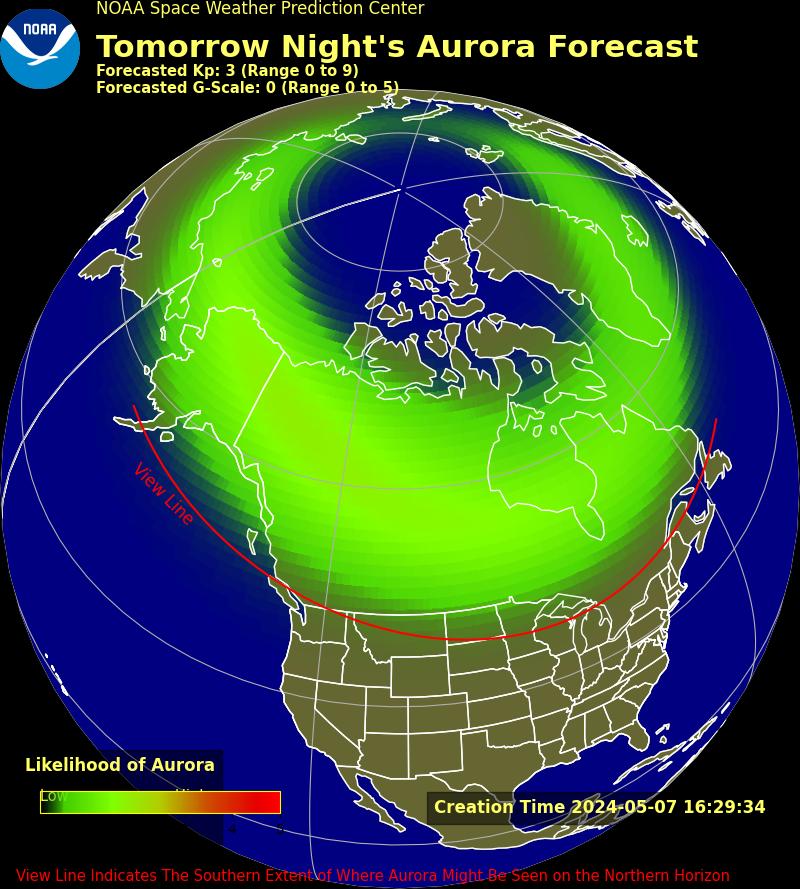 Aurora Viewing from Seattle — Basic Tips
Aurora Viewing from Seattle — Basic Tips
Aurora viewing from Seattle, basic info, tips, locations and resources.
Summary: ALWAYS LOOK NORTH, and expect it to be dim. Predicting auroras is like predicting rainbows. Predicting the conditions for them is more accurate than predicting the event itself.
Cloudcover prediction for tonight at 11pm:

This image should have today’s date on it. If it does not, click on the image and choose “Sky Cover, 11pm” from the table on the left.
Cloudcover information from NOAA
Viewline prediction for tonight:


These should have today and tomorrow’s dates on them. If they don’t, click on them to see the latest forecast. This tool is experimental, so even if you’re outside the “viewline” you may be able to see things though they’ll be closer to the horizon. This is just a prediction. Viewline from NOAA
Basics:
What: Possible aurora types: Slight greenish tinge, perhaps brighter columns or curtains in the sky, or a diffuse red glow. Do not be tricked by the normal red/yellow glow from downtown Seattle.
When: Use dateful.com/time-zone-converter to convert aurora prediction times from UTC to Pacific Daylight or Standard Time.
- It is currently: in Seattle time.
- It is currently: in UTC (what the predictions use).
Where: Always look North for aurorae. In West Seattle I recommend Westcrest Park. When clouds are predicted over Puget Sound, so I recommend viewing from Lake Kachess just past Snoqualmie Pass, or even further East. There may also be chances from Sequim or north of Everett.
How: A digital camera with a long exposure will be better at detecting the slightest glow than your eye, but once it gets bright enough you won’t need the camera anymore.
Tips:
- Alice’s Aurora Tip #1: Be patient, keep an eye on the data (see links below) until you see something. Then turn off the data and enjoy.
- Alice’s Aurora Tip #2: Look North (usually, unless the Kp number is very large, then 🤷🏼♀️). Be in a dark place.
- Alice’s Aurora Tip #3: Bring a digital camera or phone with a long-exposure setting. Long-exposure images gather more light than your eye with long exposures you may see the aurora first in a viewfinder or in an image, and with your eye as it brightens.
- Alice’s Aurora Tip #4: It is usually hard to see from Seattle, even when visible. Give your eyes a chance to adapt. Enjoy the stars too.
Kp Number:
The “Kp number” is the key to understanding the aurora forecasts. It is an index that tells you about the disturbance in the magnetic field of the Earth. It ranges from 0-9. I explained Kp over here.
What numbers should you care about?
- Over 5 means possible aurora for Seattle, but higher is better.
- 6: go outside and check.
- 7: go somewhere local that is darker than my street.
- 8: go somewhere darker and farther away, because it is going to be good.
- 9: I turn my life upside down to get to the darkest place I can–and you should too. This is rare.
Current Kp index:

This should have dates within 24+ hours of now. If it does not, click through.
Forecasts for minute-to-minute updates:
The Ovation Model – a prediction: bright green, yellow or red overlapping Seattle means go outside and look.
Soft Serve News – a prediction: Kp over 5 means possible aurora for Seattle, but the higher the better.
Space Weather Live – reporting on current conditions
Nowcast Hp30 Index – Because officially Kp is a 3-hour average I also check the “Hp30” for a similar but faster-reported index (every 30 minutes). Use the same Kp number thresholds as above with this index.
NOAA’s Space Weather Prediction Center – LOTS of info in one place.
Current Activity, Estimated Kp, – a measurement: Kp over 5 is good news. Remember the date/time along the bottom are in Universal Time so subtract 7 or 8 hours depending on daylight savings.
More:
Space Weather Woman has detailed videos that she posts often.
Advanced Solar Wind Charge/Direction – a measurement: scroll down. On the left under “Real Time Solar Wind” is a little speedometer thing labeled “Bz.” When this is pointed towards S/-50/Red we have better auroras in the Northern Hemisphere. When it is pointed the other way, the Southern Hemisphere has better aurora.
Recommended Viewing Locations:
My general stargazing location recommendations.




